Roxy the female Spanish Mastiff at 5 years old
Span-ish Mas-tif
The Spanish Mastiff is a stocky, robust, rustic-looking dog. It is very large and rather lengthy with a massive chest and the power of a heavyweight contender. The body should be rectangular, well-muscled and with strong bone. It has a massive, well-proportioned head with a deep muzzle, strong jaws, full lips and a characteristic dewlap on the neck, showing clearly his mastiff type. The Spanish Mastiff has double dewclaws on its hind feet, a characteristic this breed shares with such breeds as the Great Pyrenees. The short coat is straight with a dense under-layer and an almost wooly texture. The skin should be abundant and loose on the body. Colors include plain yellow, red, black, wolf-grey and red-brown, or broken colors or spotted. White should not be too dominant. The center of the back and the tail have longer hair. The eyes are small, commonly sporting a relaxed, carefree expression masking his ever watchful eyes. The ears are pointed and pendent. The tail is fringed and carried low. Although a very heavy breed, its movement should be free and flexible. There exist two types of Mastin Espanol: a bigger, heavier mountain type known as the Mastin Pesado (Heavy Mastiff) and a lighter, more refined steppe type called Mastin Ligero (Light Mastiff). The heavier mountain type is the type of Spanish Mastiff that participates at dog shows and expositions, since it is more impressive to look at and is most populous in the mountains in the north of Spain. This type has more head, more bone mass, more loose skin, is more "Mastiffy," has more dewlap and can weigh well over 200 lb. The lighter steppe type is faster, more agile and athletic and is more common in the Meseta and in Andalucia (in the south of Spain). However, these two types are not regarded as breeds of their own, but rather they are regional variants (the heavy type from the north and the light type from the south and central parts of the country) of the same breed and the two types often interbreed.
In character and function, the Spanish Mastin is a classic LGD (Livestock Guardian Dog) and is very similar in many ways to his cousin, the Anatolian Shepherd Dog. These dogs are dignified, noble and not overly demonstrative. They are loyal and really do love you, and will sacrifice his/her own life to protect you, your family or your livestock, when necessary. They like to be close to their owners. This breed needs a 100% firm, consistent, confident pack leader at all times. Without it, being independent-minded, they may not take your orders. Although the Mastin may appear lazy and even slothful at times, it is always watchful and alert to everything that goes on around it. It can be surprisingly quick and agile in spite of the breed's massive size and bulk. The type of owner the dog has and the people who are around it have a whole lot to do with this dog's temperament. These are not dogs for beginners. A good Mastin should be a strong, utterly fearless, self-confident and stable-minded dog. Extensive socializing and training in early puppyhood (during the critical stage between 3 and 12 weeks of age) is important if you want your Mastin to become reliable out in public and around other dogs. However, they can be socialized with a little more effort at any age. As one Spanish Mastiff Owner writes, "When Podero (my own Spanish Mastiff) was a young pup, he didn't have any socializing at all until I adopted him at 16 months of age and yet he is very reliable out in public and good with other dogs and animals." This breed is very intelligent and is capable of making its own decisions and solving problems on its own. Although smart dogs, the Mastin can be stubborn with meek owners and is not the easiest breed to obedience train. It learns quickly, but unless you present yourself in a strong pack leader manner, it may only respond to a command the first time and then become bored of it and not want to respond to it any longer. If you do not present yourself with stern, but calm authority, it may have "selective deafness" tendencies, in that it may only respond to you on its own terms and can be slow to respond to a command, especially if it doesn't feel like doing so. Avoid repeating the same commands too often during training sessions, or the dog is likely to become bored. Training advice from someone who understands LGD temperament is a very wise idea. These are generally dominant dogs and should have an owner who is consistent and knows how to display strong leadership, becomes submissive to owners once the Alpha role has been established and are usually submissive towards their "pack" members (the flock or herd it lives with). A rough approach will bring undesirable characteristics to the surface. The Mastin always sticks close to his flock or herd, keeping wolves and other predators at bay. They do not chase predators away that approach, but rather warn them with fierce, deep barking and growling to keep their distance. However, if the enemy decides not to back down, the Mastin will fearlessly and determinedly fight that predator/intruder (be it man or beast) to the death to defend what he calls his own. In Spain, shepherds often put traditional carlancas (spiked collars) on their Spanish Mastiffs to protect their neck in case they get into a fight with a wolf while defending their flock/herd. They are and were never used to herd livestock, only to guard them. They have also been used as draft dogs, pulling heavy carts over difficult terrain and with excellent results for guarding property, such as Spanish vineyards, fruit orchards, homes, large estates and in the past during Spanish Civil War, for guarding munitions. They are relatively calm dogs when adults, but as with all breeds they can be rather "turbulent" (energetic) at times when young, but once mature they are quite low-key and calm dogs. The Mastin, like many large/giant breed dogs, is very slow to mature, especially the males which do not reach their prime until 2 1/2 to 3 years of age. They are generally very tolerant of and patient with children, pets and all other family members. Being so big and strong they can unintentionally hurt a young child, especially young dogs which have a tendency to play rough.
Height: 28 - 35 inches (72 - 88 cm)
Weight: Males 185 - 220 pounds (90 - 100 kg) Females 145 - 170 pounds (52 - 77 kg)
Some of the larger males can weigh as much as 265 pounds (120 kg)
The Spanish Mastiff is the largest of all the Spanish native dog breeds and is the heaviest of the LGDs.
Beware of hip dysplasia, heart problems and Entropion (inversion of the eyelids). Also pano-ostiosis (growing pains), which occurs when they are growing puppies. This breed is prone to bloat. It is wise to feed the Spanish Mastiff several small meals rather than one big one. Births are difficult in some Spanish Mastiffs and C-sections are often needed. This breed drools and slobbers and may snore loudly.
Because of this dog’s sheer size, the Spanish Mastiff is not recommended for apartment life unless you plan to be very consistent with your pack walks, putting the dog in a rest mode for most of the day. These dogs are somewhat inactive indoors and should at least have a large yard. This dog's thick coat protects it from cold and wet so it can live outdoors. However, they are easy to housebreak and would love to live indoors close to their family. Since this breed had to endure the climate of the Meseta (a high, inland plateau located in the provinces of Madrid, Castilla-La Mancha, Castilla-Leon and Extremadura) in central Spain for thousands of years—an area of temperature extremes where it can get well over 38° C (100° F) in summer with little rainfall and below freezing in winter with heavy snow—the Mastin Español can handle both extreme heat and cold with no problems. However, it should have access to shade and water during the summer. They can adapt to any climate, but prefer dry climates over very humid ones. Heat combined with high humidity can be a problem for this breed, as Spain is, at large, a semi-arid country. The Mastin is a double-coated breed, they shed heavily twice a year and "blow" their coats in the Spring; they do shed to an extent year around. If kept as indoor dogs, will shed heavily year around, making the Mastin unsuitable for a neat and tidy home.
When fully mature, this breed has an average need for exercise. Like all giant dogs, this breed is very slow to mature, especially the males, which keep growing up until 2.5 to 4 years of age and are rather short-lived. They have a fairly low activity level and need only a moderate amount of exercise. Daily walks for about an hour twice a day is about all they need. They tend to be most active when they are young adults. This is not a breed for very active, sporty people who want a dog to jog, run alongside a bike, or play fetch or Frisbee with.
About 10-12 years. However, some can live up to 14 years or more, which is quite a long time for such a large dog breed.
About 5-10 puppies
Brush the short, dense coat regularly, especially when the dog is shedding. Keep the ear passages clean.
The Spanish Mastiff is a native to the region of Estremadura in Spain. He was for some time popular in that country. He is believed to originate from the ancient Molosser dog that can be traced back to 2000 years B.C. These dogs were probably introduced to the Iberian Peninsula by Phoenician tradesmen who had brought them from Syria or India. Mastiffs have been known to exist in Iberia for thousands of years, and the Spanish Mastiff was shown regularly at dog shows early in the 20th century, however, no Standard for the breed was drawn up until 1946. The Spanish Mastiff is a natural guard, and his inherent abilities led him to many crossings with other breeds to perfect the lesser breeds’ type. It is popular in Spain as a guard of both livestock and the home. One of the dog world's truly great droolers, this old breed still guards sheep, as it has done for centuries. The Spanish Shepherd's Association, Mesta, records how this bulky breed has been an efficient protector against wolves since the 1400s. Today a lot of individuals are kept as companions. The breed may be seen in great numbers at Spanish dog shows but is still rarely seen outside the Iberian Peninsula. The Spanish Mastiff is the national dog breed of Spain and is now the most numerous of all the native Spanish dog breeds in that country; currently around 24000 Spanish Mastiffs live in Spain. The province of Leon in northwestern Spain has the largest Spanish Mastiff population in the country, particularly in the mountains. Leon is now known as the Spanish Mastiff capital. Even though the Mastin Español (Spanish Mastiff) is a very rare breed in other countries, this is a very popular dog in his native Spain. In fact, the breed is almost as common there as the Labrador Retriever is in North America. Some of the finest, purebred, show-quality Spanish Mastiff stock can be found in both the Madrid region of Spain and in Holland and MECA (the Mastin Español Club of America). The MECA is now importing and breeding stock from those regions to work toward improving the Spanish Mastiff bloodlines in North America and educating the public on the breed. However, Holland is more recommended, because in Spain, they are more likely to sell you a pet-quality dog. Some of the Spanish Mastiff's talents include watchdog, guarding, police work, military work, tracking and hunting. The Spanish Mastiff is the father of the Portuguese Rafeiro do Alentejo and has played a role in the ancestry and development of some other Mastiff breeds such as the St. Bernard, Dogo Argentino, the recently created Asian Shepherd and possibly some others Molosser breeds known today. The breed has suffered from extensive crossbreeding with foreign Mastiff breeds, such as the St. Bernard and others, during the past few decades which caused a big decline in the numbers of purebred specimens. But the Mastin is now back to its pure form. The Spanish Mastiff has been as designated as the national dog breed of Spain.
Mastiff, Flock Guard
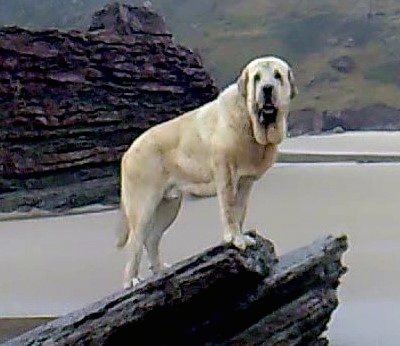
"This is Bach de Muxa, a male, purebred Spanish Mastiff at 16 months old from Asturias, Spain. He is still growing (they grow for two years or more). Bach is quiet and calm, but forceful when a stranger tries to enter his property. The Spanish Mastiff has been a guarding breed for centuries in Spain. The breed doesn't need much care, but Bach loves to be groomed."
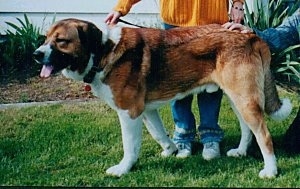
Podero the Spanish Mastiff, photo courtesy of All the Native Dog Breeds of Spain
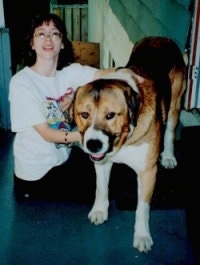
This is Podero with his owner Melanie Matthews. Photo courtesy of All the Native Dog Breeds of Spain
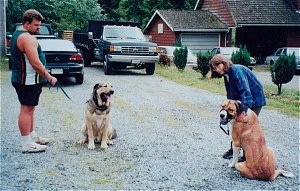
Amigo (left) with his owner and Podero (right) with his owner; Amigo and Podero are brothers. Photo courtesy of All the Native Dog Breeds of Spain
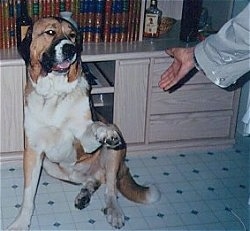
Let’s be friends! Photo courtesy of All the Native Dog Breeds of Spain
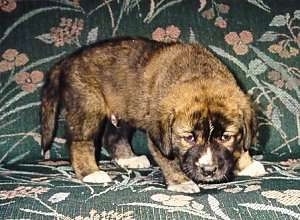
Spanish Mastiff puppy bred from show lines, photo courtesy of Mastin Español Club of America